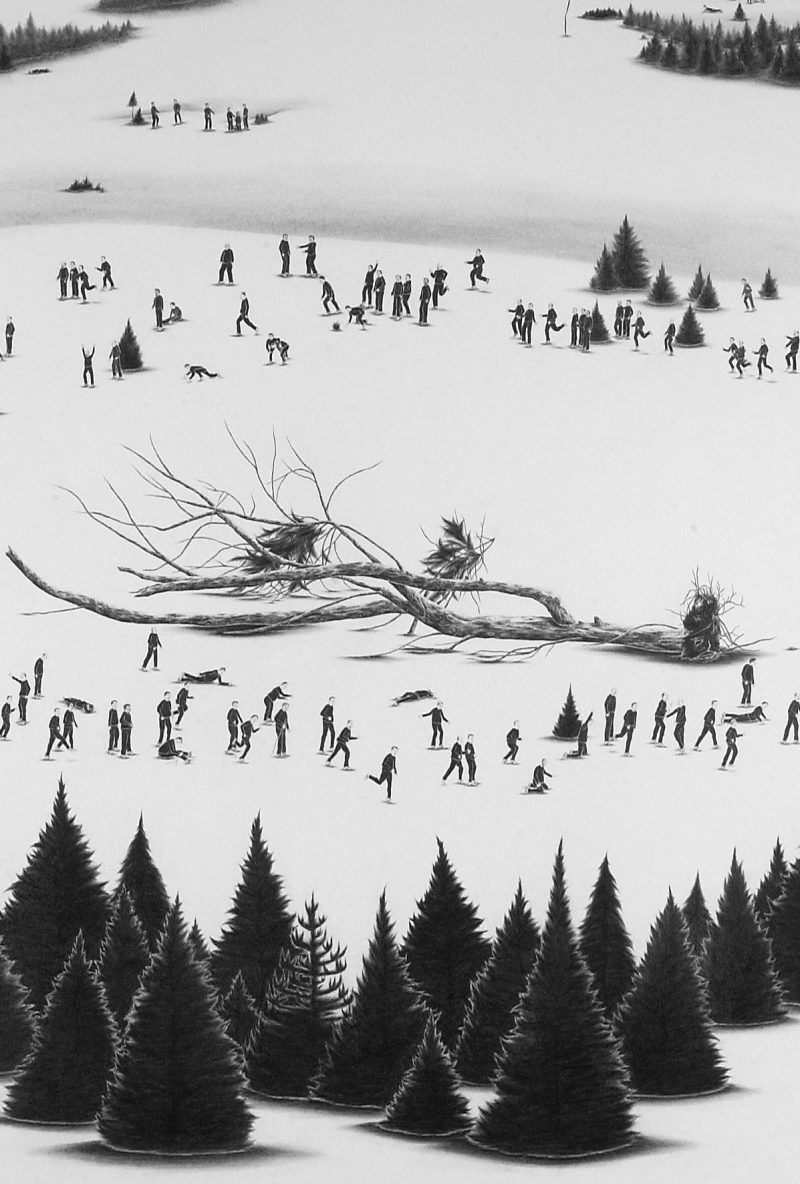I first saw Robyn O’Neil’s graphite-on-paper drawings at the Whitney Biennial in 2004. I spotted a giant triptych, a mountainous snow scene that spanned the enormous panels. I made my way over, intrigued by the countless details dotting the landscape—delicate stands of trees spaced with men, alone and in groups, all sporting identical black sweatsuits and engaged in calisthenics, falling down, lying on the white ground. Each meticulously drawn vignette was a little world of its own: five owls huddled together, a wandering elk, planes arriving in the distance. The title was Everything that stands will be at odds with its neighbor, and everything that falls will perish without grace.
A few years later, after moving to Texas, and through happy coincidence, I met O’Neil at the party of a mutual friend. Her warm, infectious laugh and animated enthusiasm are at first unexpected from the maker of such somber and ominous drawings. She was born in 1977 in Omaha, Nebraska, and the influence remains in her down-to-earth disposition, and in the individualism and straightforwardness that come through in her work. After graduate-study stints at Kings College in London and the University of Illinois in Chicago, she moved from painting to drawing, a medium she could work with at any time and in any location. Named artist-in-residence at Artpace in San Antonio in 2003, O’Neil finished her first large-scale multipanel drawing, the piece chosen for the 2004 Biennial. She has had numerous shows from that series, as it grew and evolved, in solo and group exhibitions all over the world.
O’Neil’s latest exhibition, as part of Dargerism: Contemporary Artists and Henry Darger, at the American Folk Art Museum, indicates that she is unafraid to acknowledge and applaud the array of things that inspire her. One evening in January of 2007, she sat with me in the oldest bar in Houston as we talked about the culmination of her long “end of the world” series, her process, and the concepts that inform her work.
—Hillery Hugg

Everything that stands will be at odds with its neighbor,
and everything that falls will perish without grace, 2003.
Courtesy Dunn and Brown Contemporary.
I. THE INCIDENT AT GODFATHER’S PIZZA
IN OMAHA, NEBRASKA
THE BELIEVER: So this month is the first time you’ve taken a real break since you started your “end of the world” series, seven years ago. Is this a normal way for you to work, without any kind of interruption?
ROBYN O’NEIL: I remember a distinct moment when I was about fifteen or sixteen when I made a decision. This is an awful thing to say, but I realized, Friends are taking up too much of my time,...
You have reached your article limit
Sign up for a digital subscription and continue reading all new issues, plus our entire archives, for just $1.50/month.
Already a subscriber? Sign in





